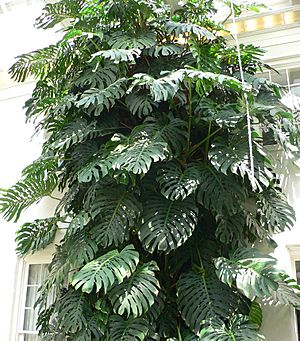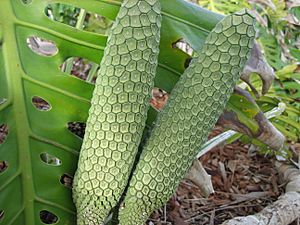Monstera deliciosa facts for kids
Quick facts for kids Monstera deliciosa |
|
|---|---|
 |
|
| Specimen at Longwood Gardens | |
| Scientific classification | |
| Genus: |
Monstera
|
| Species: |
deliciosa
|
| Synonyms | |
|
List
|
|
Monstera deliciosa, also known as the Swiss cheese plant or split-leaf philodendron, is a cool flowering plant. It originally comes from the warm, tropical forests of southern Mexico all the way down to Panama. People have brought it to many other tropical places around the world. It's also super popular as a houseplant in places with milder weather.
The name "Swiss cheese plant" is also used for a similar plant called Monstera adansonii. Another common name, "split-leaf philodendron," is sometimes used for a different plant, Thaumatophyllum bipinnatifidum. Even though it's called a "philodendron," neither of these plants are actually in the Philodendron family.
Contents
Why is it Called Monstera Deliciosa?
The second part of its scientific name, deliciosa, means "delicious." This refers to its tasty fruit. The first part, Monstera, comes from a Latin word meaning "monstrous" or "abnormal." This name describes its unusual leaves that have natural holes.
Its popular name, "Swiss cheese plant," comes from the holes that grow in its leaves. These holes look a lot like the holes you see in some Swiss-type cheeses, such as Emmental cheese.
Other fun names for this plant include delicious monster, fruit salad plant, and Mexican breadfruit. In Mexico, it's sometimes called piñanona. In places like Sicily, people call it zampa di leone, which means "lion's paw."
What Does the Monstera Plant Look Like?
This plant is part of the arum family. In the wild, it can grow up to 20 meters (about 65 feet) tall! It has large, shiny, heart-shaped leaves. These leaves can be 25 to 90 centimeters (10 to 35 inches) long and 25 to 75 centimeters (10 to 30 inches) wide.
When the plant is young, its leaves are smaller and don't have any holes or splits. But as it grows, the leaves start to develop their famous holes and splits. The older the plant gets, the more holes its leaves will have. Even though it grows very tall outside, it usually only reaches 2 to 3 meters (6 to 10 feet) when grown indoors.
Wild Monstera seedlings first grow towards the darkest spot they can find. This helps them find a tree trunk. Once they find a tree, they start to grow upwards towards the light, climbing up the tree.
The plant also has a flower that looks like a cream-white hood covering a yellowish-white stalk. These flowers can pollinate themselves, meaning they have both male and female parts.
The Delicious Fruit of Monstera
The fruit of the Monstera deliciosa can be up to 25 centimeters (10 inches) long. It looks a bit like a green ear of corn covered with hexagonal scales. As the fruit gets ripe, these scales fall off. When this happens, the fruit releases a strong, sweet smell. Some people say it smells like a mix of pineapples and bananas.
The fruit is safe and edible for humans. However, unripe fruit contains tiny, needle-like crystals that can irritate your mouth. It takes more than a year for the fruit to fully ripen. You'll know it's ready when the lowest scales turn yellow and start to lift off. As it ripens, the fruit's starch turns into sugar, making it sweet. The strong smell also becomes very noticeable when it's half-ripe.
Where Does Monstera Grow Naturally?
This plant lives in humid tropical forests. You can find it in the lowlands and middle mountains of southern Mexico, Belize, Honduras, El Salvador, Nicaragua, Costa Rica, Guatemala, and Panama.
When the seeds fall to the ground, the young plants crawl along the ground until they find a tree. They then attach themselves to the tree with their many roots. This helps the plant climb up to the canopy (the top layer of the forest) to reach the light. Wild plants can also be found in other places like Florida, Malaysia, India, Australia, and parts of the Mediterranean.
How to Grow a Monstera Plant
Monstera deliciosa is often grown outdoors as an ornamental plant in tropical and subtropical areas. It needs a lot of space and rich, loose soil. If you plant it outside, it's best to put it near a tree or a trellis so it can climb. It likes to be watered just enough to keep the soil a little moist.
This plant doesn't like cold weather. It prefers a steady temperature of at least 13 to 15 degrees Celsius (55 to 59 degrees Fahrenheit) to keep growing. It stops growing below 10 degrees Celsius (50 degrees Fahrenheit) and will die if there's frost. It needs a very bright spot, but not direct sunlight.
It's hard to make a Monstera flower outside of its natural tropical home. But in tropical places, it flowers easily, usually about three years after being planted. You can grow new plants from cuttings or by a method called air layering.
Eating the Monstera Fruit
In places where Monstera deliciosa grows naturally, its fruit is a special treat because of its sweet and unique flavor. To ripen the fruit, you can cut it when the first scales start to lift and it smells strong. Wrap it in a paper bag and let it sit until the scales begin to pop off. Then, you can brush off the scales to find the edible fruit underneath.
The fruit tastes like a mix of jackfruit and pineapple. Remember, unripe green fruits can irritate your throat. The sap from the leaves and vines can also cause skin rashes. This is because they contain a substance called potassium oxalate. That's why it's important to only eat the fruit when the scales have lifted off. You can use a little citrus juice to help remove any irritating black fibers.
Growing Monstera Indoors
Monstera deliciosa is a great plant for growing indoors because it looks cool, is easy to care for, and can handle different conditions. That's why it's a popular plant for homes and offices. It likes bright, indirect light and temperatures between 20 and 30 degrees Celsius (68 to 86 degrees Fahrenheit). You should water it when the soil feels a bit dry, usually every one or two weeks. It also needs good drainage to stay healthy. It's rare for the plant to flower when grown indoors.
In the UK, Monstera deliciosa has even won an award called the Royal Horticultural Society's Award of Garden Merit for being such a great plant.
Other Uses for Monstera
The long aerial roots of the Monstera plant have been used for different things. In Peru, people have used them as ropes. In Mexico, they are used to make baskets. In Martinique, the root is used to make a traditional remedy for snakebites. In Mexico, it's also used to help with arthritis symptoms.
Is Monstera Toxic?
Monstera deliciosa is a little bit toxic to both cats and dogs. This is because it contains tiny, needle-like crystals called calcium oxalate. If pets chew on the plant, these crystals can cause irritation and injury to their mouth, tongue, and digestive system. Direct contact with the plant's sap can also cause skin rashes in cats and dogs.
Gallery
-
Aerial root growing into a coconut coir pole
See also
 In Spanish: Cerimán para niños
In Spanish: Cerimán para niños








